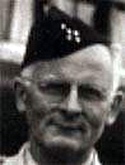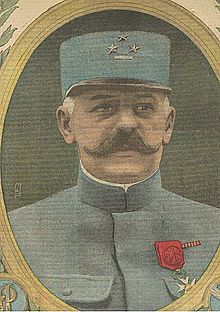The British Expeditionary Force (BEF) was the six divisions the British Army sent to the Western Front during the First World War. Planning for a British Expeditionary Force began with the 1906–1912 Haldane Reforms of the British Army carried out by the Secretary of State for War Richard Haldane following the Second Boer War (1899–1902).

IX Corps was a corps-sized formation of the British Army that existed during the First and the Second World Wars.

Robert Georges Nivelle was a French artillery general officer who served in the Boxer Rebellion and the First World War. In May 1916, he succeeded Philippe Pétain as commander of the French Second Army in the Battle of Verdun, leading counter-offensives that rolled back the German forces in late 1916. During these actions he and General Charles Mangin were accused of wasting French lives. He gives his name to the Nivelle Offensive.

The Polish Legions was a name of the Polish military force established in August 1914 in Galicia soon after World War I erupted between the opposing alliances of the Triple Entente on one side and the Central Powers on the other side, comprising the German Empire and Austria-Hungary. The Legions became "a founding myth for the creation of modern Poland" in spite of their considerably short existence; they were replaced by the Polish Auxiliary Corps formation on 20 September 1916, merged with Polish II Corps in Russia on 19 February 1918 for the Battle of Rarańcza against Austria-Hungary, and disbanded following the military defeat at the Battle of Kaniów in May 1918, against Imperial Germany. General Haller escaped to France to form the Polish army in the West against the anti-Polish German-Bolshevik treaty.

Charles Emmanuel Marie Mangin was a French general during World War I.

The Third Battle of the Aisne was part of the German spring offensive during World War I that focused on capturing the Chemin des Dames Ridge before the American Expeditionary Forces arrived completely in France. It was one of a series of offensives, known as the Kaiserschlacht, launched by the Germans in the spring and summer of 1918.

The Russian Expeditionary Force [REF] was a World War I military force sent to France and Greece by the Russian Empire. In 1915, the French requested that Russian troops be sent to fight alongside their own army on the Western Front. Initially they asked for 300,000 men, an unrealistically high figure, probably based on assumptions about Russia's 'unlimited' reserves. General Mikhail Alekseev, the Imperial Chief of Staff, was opposed to sending any Russian troops, although Nicholas II finally agreed to send a unit of brigade strength. The first Russian brigade finally landed at Marseille in April 1916.
The Tenth Army was a Field army of the French Army during World War I and World War II.
The Sixth Army was a field army of the French Army during World War I and World War II.

The Allied leaders of World War I were the political and military figures that fought for or supported the Allied Powers during World War I.

André Zeller was a French Army general. He served during World War I, the Franco-Turkish War, and World War II, and served as chief of staff of the French Army during the Algerian War.

Henri Mathias Berthelot was a French general during World War I. He held an important staff position under Joseph Joffre, the French commander-in-chief, at the First Battle of the Marne, before later commanding a corps in the front line. In 1917 he helped to rebuild the Romanian Army following its disastrous defeat the previous autumn, then in summer 1918 he commanded French Fifth Army at the Second Battle of the Marne, with some British and Italian troops under his command. In the final days of the war he again returned to Romania, helping fight the Hungarians during the Hungarian–Romanian War and then briefly commanded French intervention forces in southern Russia in the Russian Civil War, fighting the Bolsheviks in Bessarabia (1918).

Major General William Weigel was a United States Army officer who, throughout his long military career, served in numerous conflicts and wars, most notably towards the end of World War I, commanding the 56th Brigade of the 28th Division before taking command of the 88th Division in the war's final weeks.

Louis Ernest de Maud'huy (1857–1921) was a French World War I general and the first Chief Scout of Scouts de France.
Louis Charles Émile Gibon-Guilhem (1862–1945) was a French Infantry Brigadier General born in Rueil-Malmaison, France. Serving on the German front during World War I he was instrumental in the victory of allied forces in 1918.
Henri Alexis Joseph Vanwaetermeulen was a French general of the First World War who began his career as a private soldier. Enlisting into a line regiment in 1883 Vanwaetermeulen was promoted to sergeant major within two years and received his commission within five. He transferred to the Troupes de marine and saw service in several French colonies. In Tonkin Vanwaetermeulen was mentioned in dispatches for leading assaults on two forts and received the Colonial Medal. He saw further service in Madagascar, Senegal and Mauritania, much of it under the command of Joseph Gallieni, and by the outbreak of the First World War was a lieutenant-colonel.

Joseph Alfred Micheler was a French general in the First World War.

Max Ferdinand Karl von Boehn was a German officer involved in the Franco-Prussian War and World War I. He held the rank of Generaloberst in World War I.

Charles Victor Jacquot (1862-1922) was a French general during World War I. He commanded the 6th Infantry Division throughout the war as well as participating across key battles of the Western Front.
Hubert Conway Rees was a British Army officer. The only son of a Church of England clergyman, Rees was born in Conway, Carnarvonshire. After an education at Charterhouse School in Surrey Rees joined the 3rd (Militia) Battalion of the East Surrey Regiment and served as a subaltern in the Second Boer War. In 1903 he transferred to the regular army, joining the Welsh Regiment as a second lieutenant. By the start of the First World War in 1914 he had risen to captain. Rees fought with his battalion during the Retreat from Mons and the First Battle of the Aisne and was awarded the Distinguished Service Order for his actions in assisting a neighbouring battalion in the First Battle of Ypres. Rees was one of the few survivors of his battalion after a 31 October action at Gheluvelt Chateau and assumed command of the unit until January 1915. He afterwards served in Britain at the Royal Military College, Sandhurst and as a divisional staff officer.
This page is based on this
Wikipedia article Text is available under the
CC BY-SA 4.0 license; additional terms may apply.
Images, videos and audio are available under their respective licenses.














